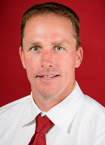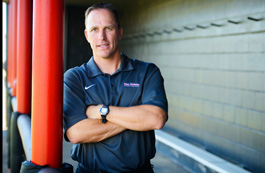Sept. 17, 2013
Meet Cal
State Northridge's Greg Moore
By Sean Ryan
CollegeBaseballInsider.com
Co-Founder
sean@collegebaseballinsider.com
@collbaseball
 For
most of his college baseball career, Greg Moore has suited up
for San Francisco. For
most of his college baseball career, Greg Moore has suited up
for San Francisco.
As a player, he pitched and was a backup catcher
for the Dons, and an inspiration award given by the baseball
program bears his name. As a coach, he most recently guided
USF’s pitchers and saw three of his players selected in the
first round of the Major League Draft during his time in the
dugout.
One of Baseball America’s top 10 assistant
coaches, Moore becomes a head coach for the first time,
inheriting a Matadors team that went 15-12 in the Big West and
31-26 overall.
First Inning - You’ve spent the majority of
your playing and coaching career at San Francisco. What will you
miss about being a part of the Dons?
I’ll miss the people. Coach Giarratano is an
impressive leader. The other coaches, players and alums truly
understand and enjoy why they are at USF.
Second Inning - What are some of the things
you liked about this opportunity?
I was drawn to the energy and vision of CSUN’s
new President, Dianne Harrison, and of course our new AD, Dr.
Brandon Martin. This is a new phase of building at this
University. I’m grateful to be part of it.
Third Inning - At age 36, how does your age
help or hinder you as a coach?
I’m sure that I’ll be a better coach in 10 years
than I am now. But, my work is to make the players better in the
next 10 minutes, 10 days and 10 years. That’s true at any age.
 Fourth
Inning - You have an award at San Francisco named after you for
inspiration – how did that come about and what is it like to be
the namesake for the award? Fourth
Inning - You have an award at San Francisco named after you for
inspiration – how did that come about and what is it like to be
the namesake for the award?
At that time and after a few injuries, I was one
of the rare players to receive a sixth year of eligibility. Some
must have found inspiration in finding a way to be a college
baseball player for the over half of a decade.
Fifth Inning - What are a few of the most
important things about being a head coach that you learned from
Dons coach Nino Giarratano?
There is a long list of what I learned from Coach
G. A new lesson or two appears on that list every day. Among the
many, he teaches to simply center decisions on the right values.
Most decisions are easy to make but difficult to communicate. He
does both as well as anyone I’ve been around or studied in
coaching.
Sixth Inning - What will be the toughest thing
about being a head coach for the first time?
I’ve had to become a better delegator. It still
needs work but is a developing skill.
Seventh Inning - Tell me about Diamond
University.
Diamond University is a formalized 10-week class
and an idea. We meet once a week to talk about lessons from the
business and family. We compare and relate to the sports and
team life that student-athletes live. What we find is that this
enjoyable way to learn both baseball and life is usually a
reminder of what our parents told us. The book “7 Habits of
Highly Effective People” is the text book. From this class we
do our community service, our campus outreach and individual
goal-setting.
The idea is that we can always compare the skills
and habits it takes to accomplish one task, and apply them to
another. Taking out the trash, or writing a paper well is a lot
like making a pitch. The class is discussion-based and in large
part supported by the book.
Eighth Inning - What are three things that you
look for when recruiting pitchers?
We look for those who are steady in their
presence and can let the ball go out front. For one reason or
another pitchers sometimes struggle, either physically or in
their approach to be fully committed to the pitch. When a
pitcher has a knack for both we evaluate on to late life and
stuff.
Ninth Inning - What are three things high
school pitchers should focus on to better prepare them for
college? What are some of the things you have to “fix” with
young college pitchers?
High school pitchers who focus on execution are
best-prepared. How many pitches did I make out of the 100 I
threw in today’s game or the 25 I threw in flat ground? At its
simplest form pitching is hitting the spot.
If that becomes the focus then the priorities
become pace, tempo and competing, rather than mechanics,
velocity and showcasing. We often work fix the “showcase”
mentality when pitchers get to campus. Some pitchers come in
fixed on guns and line scores. I think it comes back to
empowering pitchers to return to some of the simplicity of being
12 again.
(photos courtesy of CSUN Media Relations Office)
|